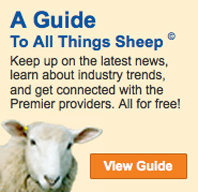
USEFUL ITEMS TO KEEP ON HAND
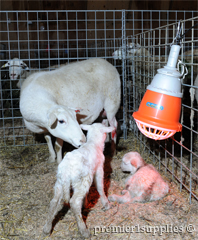 Heat Lamp
Heat Lamp
| • |
To warm lambs, kids and sick animals |
| • |
Use in barns or stables for any animal that is sick or cold |
| • |
Safer than other lamps |
| • |
Versatile and effective |
| • |
Durable |
| • |
Heavy-duty plastic shield keeps animals from damaging bulb |
| • |
Very robust |
Infrared bulb
| • |
"Never-loose" base—does not have a cement adhesive connection, which deteriorates and will fail over time. Instead, the base screws into the bulb. A weld of solder holds the base onto the threads. NOTE: If a never-loose base ever becomes loose, Premier will replace at no cost! |
| • |
6-month non-stop life. |
| • |
We prefer the pressed glass bulbs because of their tough and rugged PAR glass. |
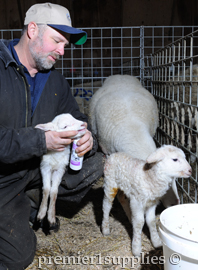 Nutri-Drench™
Nutri-Drench™
Provides quick, safe nourishment for "near-death" situations. Use to treat pregnancy toxemia, enterotoxemia, E. coli ("watery mouth"), fly strike and any that are too heavily stressed by parasites, weather, lactation or pneumonia.
Click here to view all of Premier's lambing supplies.
NAVEL TREATMENT
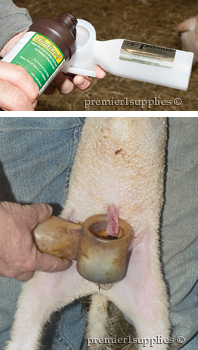
Dipping navels reduces potential disease (such as navel joint ill) and dries the umbilical cord much faster.
Navel Cup
To prevent navel infection in newborns in lambing sheds. Navel cups enable treatment of navels with less mess and waste—so the disinfectant ends up on the lamb's navel and not on you!
Triodine-7
A very effective management product that quickly sanitizes and dries navel cords on newborns, which drastically reduces the risk of infection via the navel. Those that have used iodine in the past will appreciate the arrival of an equivalent alternative.
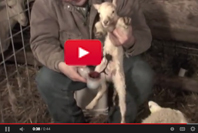
A video demonstrating how to dip a navel using a navel cup.
LIVESTOCK TREATMENTS
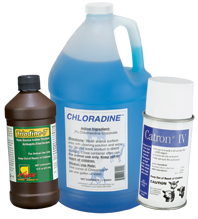 Triodine-7
Triodine-7
A very effective management product that quickly sanitizes and dries navel cords on newborns which drastically reduces the risk of infection via the navel. Those that have used iodine in the past will appreciate the arrival of an equivalent alternative.
Chloradine™
2% Chlorhexidine Gluconate. Wash animal surface area with cleaning solution and wipe dry. Do not leave product in direct sunlight. Close container after use. Use 1 oz. of Chloradine per 1 gallon of water.
Catron® IV
The best product for treating sheep with flystrike. One can will treat from 1 - 10 animals depending on severity of fly-strike.
|
 |
 |
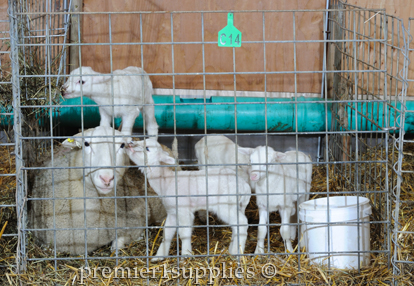
And you thought your day was rough? Try giving birth to 4 lambs only to have them use you as a jungle gym for the next month! The ewe is in a jug made with our panels. Jug is identified using and easy to read Z Tag.
Lambing Season
Premier is one month into our lambing season and things have been busy. Over 100 ewes have lambed and for a few days it seemed one ewe lambed per hour. We are using the same lambing system as we did last year, but we started earlier (mid December). For more info on our lambing system, check out our Guide and past newsletter.
The 3 articles below provide useful information for lambing season.
Stay warm,
The Folks at Premier
EXTENSION NEWS
Grafting: A Lamb Saving Management Tool
By A. Richard Cobb, Extension Sheep Specialist, University of Illinois
Grafting (Fostering) is an alternative for producers who do not enjoy raising lambs on artificial milk. While it is true that lamb milk replacers have improved dramatically in recent years, the ability to graft, or switch, a lamb from one ewe to another is a management tool that can save many lambs during a lambing season.
Grafting works best when you have a number of ewes lambing at the same time. When grafting, we are asking one ewe to adopt or accept another ewe’s lamb or lambs. Grafting can be done for many reasons. Examples of situations where removal of one or more lambs will benefit the lambs and the ewe are:
| • |
A ewe has more lambs than she can successfully care for. |
| • |
A ewe becomes sick or dies, leaving orphan lambs. |
| • |
A ewe does not have enough milk to adequately feed the lambs she has. |
| • |
A ewe lambs with multiple lambs but she is young, or old, or is very thin. |
| • |
A ewe has only a half udder and has twins or triplets. |
First let’s establish names for the various animals we will be discussing.
Foster ewe. This is the ewe we are grafting the lamb onto.
Mother. The birth mother of the lamb we are grafting.
Alien. The lamb we will be grafting onto the foster ewe.
The selection of a foster ewe can make or break the adoption and Producers should be continually searching for them. A good foster ewe should:
| • |
Be above average in Body condition score. A thin ewe will have problems producing enough milk for two lambs. |
| • |
Be calm by nature. A nervous or crazy ewe will not work. |
| • |
Have a good milk supply. |
| • |
Have teats suitable for nursing. Teats should not be too large and their location and angle from the body should make it easy for the lamb to find them. |
Slime Grafting
The slime method can be used only while the foster ewe is lambing. Due to the high maternal instinct of most ewes, they can be fooled into thinking they have given birth to two lambs instead of just one. To accomplish this graft, the shepherd must have in mind a lamb that will benefit from being grafted. Shepherds should make each lamb stand at least twice a day and observe their reaction. A healthy, lamb that has enough milk will stretch when it stands. A lamb that is not getting enough milk will not stretch but will immediately look for milk. A lamb that is obviously not thriving is also a good choice for an alien lamb. The alien lamb must be able to stand and move about for any graft to be successful. If the lamb is down, it needs immediate intensive care.
When a potential foster ewe lambs, with a single, the shepherd should check to make sure. This is done by inserting your hand into the body cavity of the ewe and feeling for another lamb. Be as sanitary as possible doing this. Wear a plastic glove or breeding sleeve and lubricate it for ease of entry. If there is no second lamb then prepare the alien lamb for grafting. If possible, match the size of the alien with the size of the foster ewe’s own lamb. If one is much larger than the other this can lead to problems with one lamb consuming most of the milk. Color does not seem to be a problem when grafting. A black lamb can be grafted onto a white-faced ewe that has a brockle faced or white lamb.
Read More »
RINGWOMB OR EARLY DILATION SYNDROME
Do You Know the Difference?
By Patrick Phillips, DVM, DACT and Swanand Sathe, BVSc, DACT
With the upcoming lambing season, dystocia (difficult lambings) will occur within nearly every flock at one time or another. On a percent basis, failure of complete cervical dilation accounts for 18 to 33 percent of reported dystocias. The key aspect to managing these problems are to understand the difference between true Early Dilation Syndrome and Ringwomb, and its long term consequences within your flock.
What is Early Dilation Syndrome (EDS)?
Early Dilation Syndrome (EDS) is considered a separate clinical syndrome from "Ringwomb". Although both present with similar clinical signs and treatments, the cause and age groups differ significantly. EDS is primarily seen in yearling ewe lambs and virgin 2 year olds, but not older ewes. Presentation differs as well. The ewes presenting with EDS are typically 2 to 3 weeks early from their due date and either have very little mammary development or can "bag up" overnight. By truest definition, these are truly an abortion in progress. When examined, these ewes will usually present with fetal membranes protruding from the vulva and upon examination the lamb or lambs are dead and macerated. If alive, the lambs are premature and weak. Vaginal exam will usually reveal a cervix that is 1 to 2 fingers dilated and firm to the touch. Attempts to deliver by vaginal delivery is not recommended since manual extraction may lead to tearing, peritonitis and death of the ewe. Caesarian Section is recommended.
Early Dilation Syndrome differs from true Ringwomb in numerous ways. First, the age group differs significantly. Ringwomb occurs in older ewes compared to EDS which is seen in nulliparous (virgin) ewes lambs. Unlike true Ringwomb, EDS does not appear to have a genetic component and does not seem to reoccur in subsequent years. If we consider EDS to truly be an abortion syndrome we have to be concerned with the cause and potential flock health. Causes of abortion can involve infections, toxins, physiological or nutritional components. When any of these causes rear their ugly heads, 5 to 30 percent of the young stock can be affected by abortions and EDS in a given year. It is imperative that your health care professional becomes involved to help determine the cause and future prevention if and when EDS occurs in your flock.
What is Ringwomb?
Ringwomb is best described as the failure of the cervix to dilate sufficiently during parturition in order to promote delivery of the lambs. It has been most commonly observed in ewes that have previously borne offspring (multiparous) and are carrying multiple fetuses. An interesting thing to note is that this particular condition is not due to infection, abnormal positioning of the lambs in the birth canal, premature delivery or mineral and nutritional deficiencies. It is simply the failure of the cervix to respond to hormones that are responsible for the delivery process or sometimes even due to abnormal secretion of these hormones. Ringwomb condition can occur at the expected lambing date or may be associated with a prolonged pregnancy of up to 14 days.
The easiest way to recognize ringwomb in sheep is the presence of fetal membranes protruding from the vulva with no sign of labor. Some animals do not show the typical signs that are associated with labor such as isolation from the flock, lack of appetite or even swelling and relaxation of the external genitalia. There may be poor or slow udder development with improper milk letdown and very firm teat canal. Upon examination of the vaginal canal an insufficiently dilated cervix which permits only one or two fingers is usually common. The uterine contractions are therefore ineffective in pushing out the lambs. The placenta will usually separate during this time resulting in loss of blood supply from the ewe to the lambs which can result in a high percentage of lamb losses (up to 35%) in affected flocks. In an event that live lambs are delivered, these usually are weak and may die later.
If a ewe with ringwomb is left alone to deliver, there is no change seen in the degree of cervical dilation and delivery of lambs does not occur. Instead the cervix will start to close after two or three hours and this results in death of the lambs. The ewe will then try to expel the dead lambs out after 48 hours. This is usually associated with infection and sepsis and can cause death of the ewe as well.
The most effective treatment is aimed at delivering the lambs as soon as possible to ensure their survival. Cesarean section is the most effective way that the lambs can be delivered rapidly and is safe for the ewe as well, especially when performed early on at the onset of labor. Sometimes when veterinary assistance is unavailable and the cervix cannot be dilated as well, it is best to start the ewe on antibiotics until veterinary help is available. This will help in possibly preventing death of the ewe due to infections and sepsis. Most ewes will breed back in the following season and may not suffer consecutively from ringwomb again. However, exceptions do occur as this condition has been suspected of having a genetic component as it is observed more frequently in certain ewe families. It is best to cull such animals from the flock.
The following factors play an important role in Ringwomb:
Breed: Ringwomb has been observed in pure as well as crossbred animals. Some breeds such as Dorset Horn, Suffolk, South Devon, Leicester, and halfbred ewes show increased incidences.
Body condition: Does not seem to be a factor in whether an animal will suffer from ringwomb or not.
Age: Majority of cases occur in ewes two years and older.
Number of lambs: Ringwomb condition has been associated with ewes carrying multiple lambs.
Since the exact cause for the ringwomb condition is not known, it is easier to identify and cull animals that have had an incidence of ringwomb, or animals that have the familial history of this condition. Equally important is to identify if the introduction of a new ram in the flock has caused an increased incidence of ringwomb among his daughters, and to cull such rams as well as the daughters from the flock. Families with the condition and those ewes previously affected should not be used for breeding.
Early detection and prompt treatment is the best way to reduce the lamb losses associated with ringwomb. Early signs indicating or identifying a ewe with ringwomb are labored breathing while lying down and abnormally large amounts of thick, clear, vaginal mucus discharge with no progression of labor. Ewes should be fed a good quality ration during the last six weeks of pregnancy and every effort should be taken to minimize stressful conditions.
The bottom line is that Ringwomb needs to be differentiated from Early Dilation Syndrome (EDS). It is best to consult with your veterinarian regarding future management strategies, prevention and early detection of these conditions that have a higher incidence in a particular flock.
Dr. Phillips and Dr. Sathe are Theriogenologist (Reproductive Specialist) at Iowa State University College of Veterinary Medicine.
Reprinted with permission from the December 2013 issue of the Lamb & Wool Newsletter, a publication of the Iowa Sheep Industry Association.
LAMB SURVIVAL
The first 24 hours—
Today’s shepherds are different from those of 50 years ago. Most shepherds nowadays have very little time to spend with the lambs—an hour or so in the morning and then it's off to their day job for 8 to 10 hours. If shepherds work close to home, then they may also have a couple of evening hours to spend in the barn.
If we can get the lamb through the first 24 hours, its chance of survival is greatly increased. Below are a few things that will help the lambs and the shepherd survive cold weather lambing.
| • |
First of all, strong healthy lambs come from ewes that are the same. Make sure your ewes are in good shape before breeding and do not lose too much condition during gestation. Putting them on the best feed you have 6 weeks before lambing will help to make sure the ewe has plenty of milk and the lamb has a good supply of fat where he needs it. This gives the lamb the strength to get up and start nursing as soon as he is born. There is nothing better to see when you walk into the barn than a set of healthy newborn twins nursing with their tails wagging. |
| • |
Create a routine that makes every minute count, beginning when you first walk into the lambing barn. |
| • |
Ewes have a wax plug in their teats. In cold weather that plug can be difficult for weak lambs to suck out. So grab each ewe that lambs and strip out each teat to make sure there is plenty of milk for the lambs. |
| • |
The next step is to take the temperature of each lamb. Your body temperature is 98.6, and the lambs' temp should be 102. If you put your finger into the lamb’s mouth and it feels warm, he is fine. If his mouth feels cold, you have a lamb that is in trouble. |
| • |
For any lamb that is warm, all you need to do is to dip the navel into Triodine-7 to help stop infection and they should be fine. |
| • |
The cold lambs need help right away. First try to get the lamb to suck for himself. If he will not, you will need to tube-feed him. I like the 140 cc syringe and plastic tube the best for this. The 60 cc is too small and must be refilled several times in order to get enough milk in the lamb. A 10-pound lamb needs 50 cc of milk every hour. By giving him a feeding of 140 cc, he has about 3 hours to gain his strength and begin to nurse on his own. Also, I do not like putting a tube down the lamb's throat too often--this can make it sore to the point where the lamb does not want to swallow. I like the plastic tube because it's easier to use on a lamb that fights you. In very cold barns the red tube is better as it will stay flexible. |
THIS IS VERY IMPORTANT: If a lamb cannot hold its head up on its own, do not tube-feed it. Many lambs die because they are too cold and weak when being tube-fed, and they drown from the milk. You must first warm up the lamb. Put a heat lamp over the lamb until he can control his head. Then it's safe to feed him.
Heat lamps are a great source of warmth when needed, but do not overdo it. When a healthy lamb gets cold, he needs to get up and eat to stay warm. They can become too dependent on heat lamps.
To make sure the lambs have a good start, some shepherds who have the time will tube-feed every lamb that is born with colostrum from its mother. Or, you may want to use Nutri-Drench (this is not a substitute for colostrum), a product that works well to start all lambs. One pump to each lamb will give them a boost to improve their chances during the first 24 hours.
If your barn temperature is below freezing and you need to be away, put a lamb cover on each of the newborn lambs. It will help them to adjust to the cold before losing too much heat. When you return to the barn, remove the cover and the lamb should be fine.
So remember:
Enjoy your lambing season. It does not need to be stressful.
-Gordon Shelangoski,
Premier Consultant and Product Development
|
|